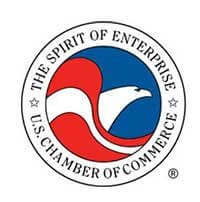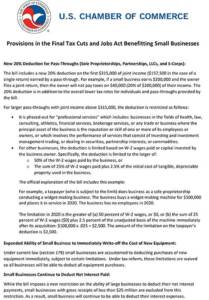16 Jan Provisions in the Final Tax Cuts and Jobs Act Benefiting Small Businesses
 We recently received some small business information from Paul Hamilton, Chairman Economic Development & Taxation Policy Committee aand want to pass this on to all of our local Valdosta small businesses.
We recently received some small business information from Paul Hamilton, Chairman Economic Development & Taxation Policy Committee aand want to pass this on to all of our local Valdosta small businesses.
The Economic Development & Taxation Policy Committee has already been hard at work to identify and promote 2018 legislative priorities to help improve our business climate in Valdosta-Lowndes County.
New 20% Deduction for Pass-Throughs (Sole Proprietorships, Partnerships, LLCs, and S-Corps):
The bill includes a new 20% deduction on the first $315,000 of joint income ($157,500 in the case of a single return) earned by a pass-through. For example, if a small business earns $200,000 and the owner files a joint return, then the owner will not pay taxes on $40,000 (20% of $200,000) of their income. The 20% deduction is in addition to the overall lower tax rates for individuals and pass-throughs provided by the bill.
For larger pass-throughs with joint income above $315,000, the deduction is restricted as follows:
- It is phased-out for “professional services” which includes: businesses in the fields of health, law, consulting, athletics, financial services, brokerage services, or any trade or business where the principal asset of the business is the reputation or skill of one or more of its employees or owners, or which involves the performance of services that consist of investing and investment management trading, or dealing in securities, partnership interests, or commodities.
- For other businesses, the deduction is limited based on W-2 wages paid or capital invested by the business owner. Specifically, the deduction is limited to the larger of:
- 50% of the W-2 wages paid by the business, or
- The sum of 25% of W-2 wages paid plus 2.5% of the initial cost of tangible, depreciable property used in the business.
The official explanation of the bill includes this example:
For example, a taxpayer (who is subject to the limit) does business as a sole proprietorship conducting a widget-making business. The business buys a widget-making machine for $100,000 and places it in service in 2020. The business has no employees in 2020.
The limitation in 2020 is the greater of (a) 50 percent of W-2 wages, or $0, or (b) the sum of 25 percent of W-2 wages ($0) plus 2.5 percent of the unadjusted basis of the machine immediately after its acquisition: $100,000 x .025 = $2,500. The amount of the limitation on the taxpayer’s deduction is $2,500.
Expanded Ability of Small Business to Immediately Write-off the Cost of New Equipment:
Under current law (section 179) small businesses are accustomed to deducting purchases of new equipment immediately, subject to certain limitations. Under tax reform, these limitations are waived so all businesses will be able to deduct all equipment purchases.
Small Businesses Continue to Deduct Net Interest Paid:
While the bill imposes a new restriction on the ability of large businesses to deduct their net interest payments, small businesses with gross receipts of less than $25 million are excluded from this restriction. As a result, small business will continue to be able to deduct their interest expenses.
Click on the image to download the PDF



